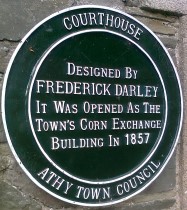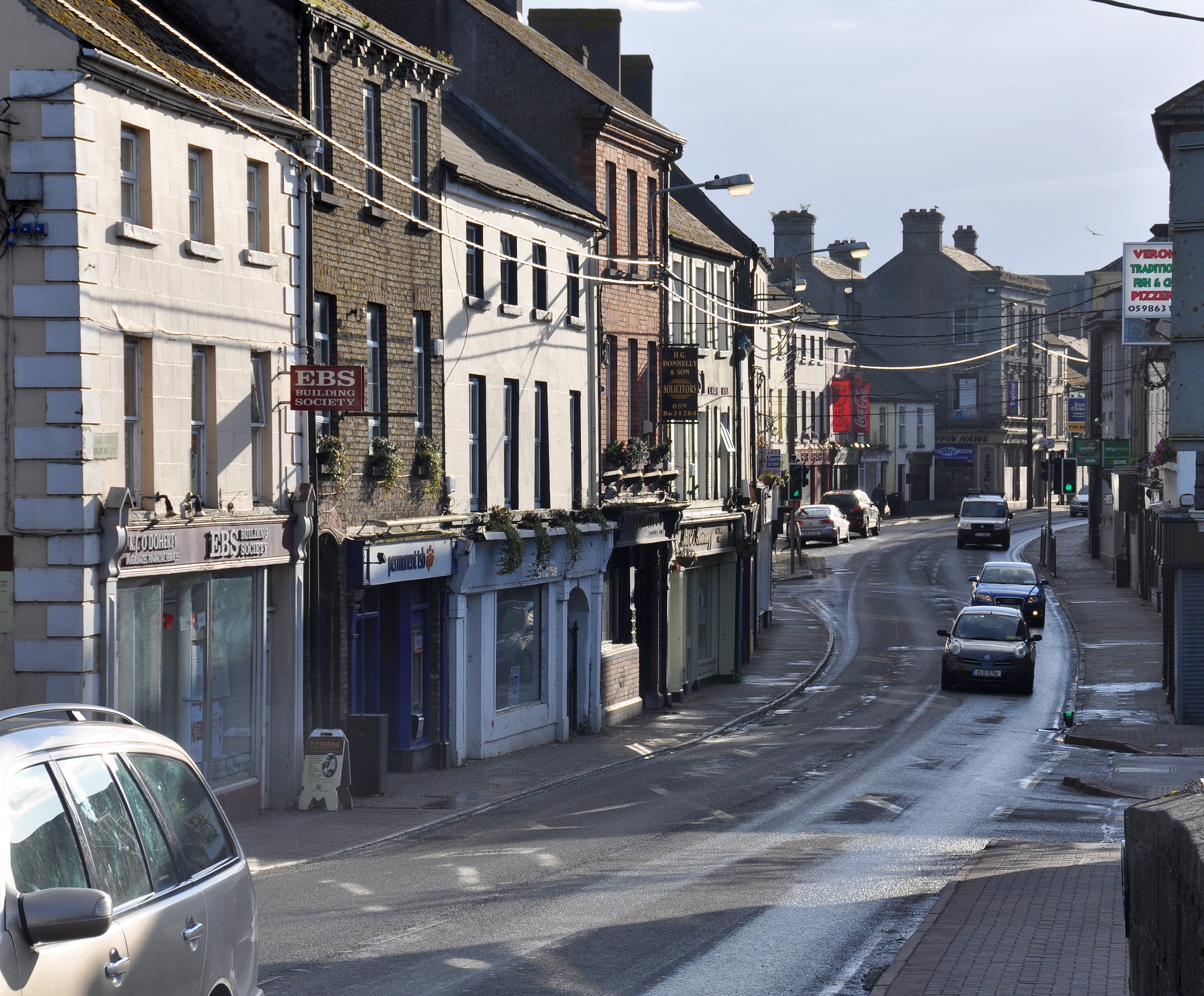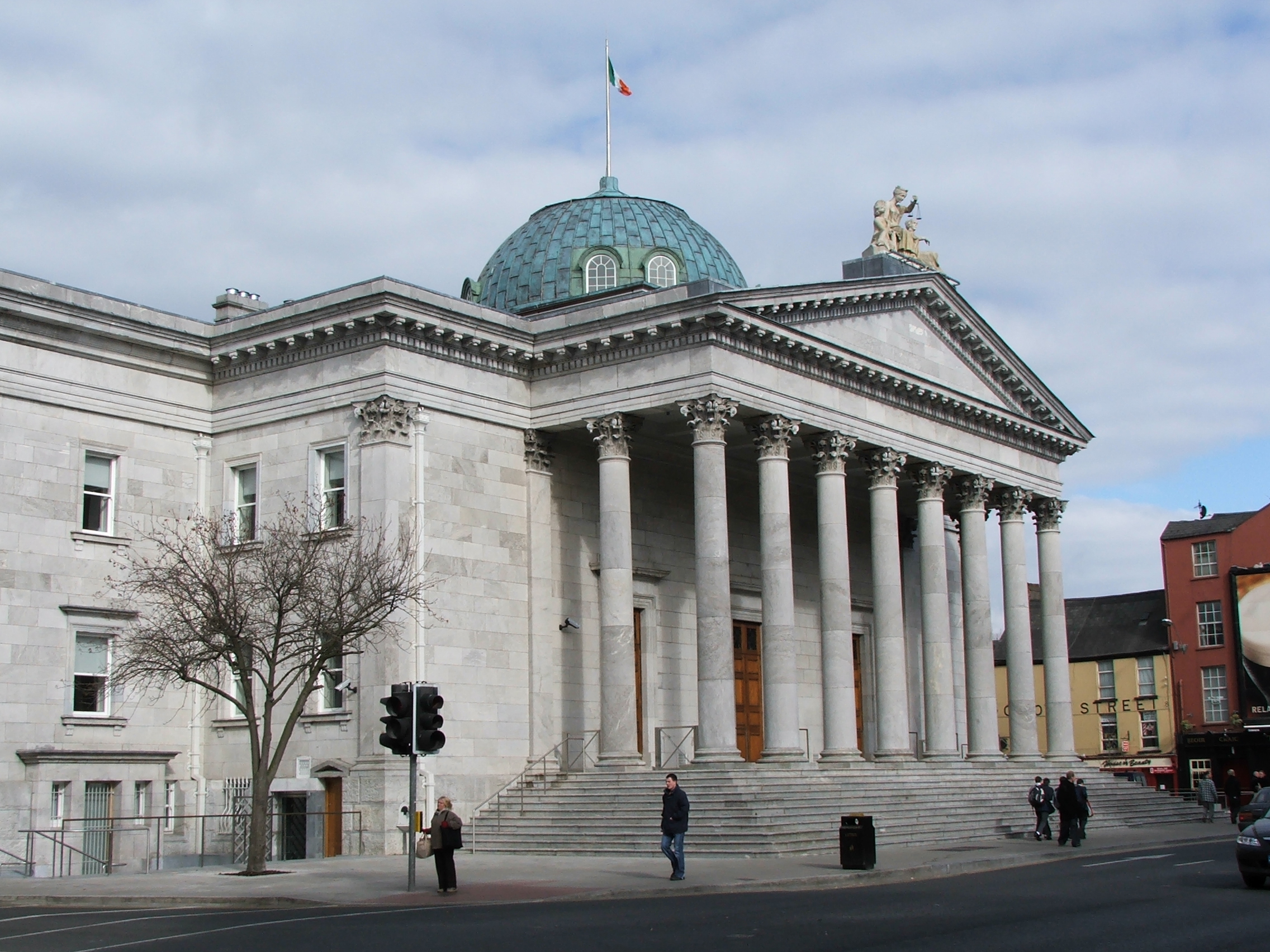|
Athy Courthouse
Athy Courthouse is a judicial building in Emily Square, Athy, County Kildare, Ireland. The structure, which was previously used as a corn exchange, is listed on the National Inventory of Architectural Heritage. History The building was commissioned in the mid-19th century as a corn exchange by Augustus FitzGerald, 3rd Duke of Leinster, whose seat was at Carton House. It was designed by Frederick Darley in the Tudor Revival style, built in rubble masonry and was officially opened on 6 October 1857. The design involved a central courthouse block with a single storey loggia of four bays on either side. There was originally a small porch at the north end, although this was later converted into a toilet, and an office block of four bays at the south end. Above the loggia, there were three sash windows with architraves surmounted by moulded gables with finials. Internally, the principal room was the main hall which was long and wide. Large quantities of corn were purchased there ... [...More Info...] [...Related Items...] OR: [Wikipedia] [Google] [Baidu] |
Athy
Athy ( ; ) is a market town at the meeting of the River Barrow and the Grand Canal in south-west County Kildare, Ireland, 72 kilometres southwest of Dublin. A population of 11,035 (as of the 2022 census) made it the sixth largest town in Kildare and the 45th largest in the Republic of Ireland, a growth of 82% since the 2002 census. Name Athy or is named after a 2nd-century Celtic chieftain, Ae, who is said to have been killed on the river crossing, thus giving the town its name "the town of Ae's ford". The ''Letters of the Ordnance Survey'' (1837) note that "The town is now called by the few old people who speak Irish there and in the Queen's County /nowiki>Laois">Laois.html" ;"title="/nowiki>Laois">/nowiki>Laois/nowiki>, , pronounced Blahéé", where ''éé'' stands for English 'ee' [i:] as clarified by a note written in pencil in Irish as ''Blá thí''. History According to Elizabethan historian William Camden, Ptolemy's map of Ireland circa 150 AD names the Rheban d ... [...More Info...] [...Related Items...] OR: [Wikipedia] [Google] [Baidu] |
Finial
A finial () or hip-knob is an element marking the top or end of some object, often formed to be a decorative feature. In architecture, it is a small decorative device, employed to emphasize the Apex (geometry), apex of a dome, spire, tower, roof, or gable or any of various distinctive ornaments at the top, end, or corner of a building or structure. A finial is typically carved in stone. Where there are several such elements they may be called pinnacles. The very top of a finial can be a floral or foliated element called a bouquet. Smaller finials in materials such as metal or wood are used as a decorative ornament on the tops or ends of poles or rods such as tent-poles or curtain rods or any object such as a piece of furniture. These are frequently seen on top of bed posts or clocks. Decorative finials are also commonly used to fasten lampshades, and as an ornamental element at the end of the handles of souvenir spoons. The charm at the end of a pull chain (such as for a ceiling ... [...More Info...] [...Related Items...] OR: [Wikipedia] [Google] [Baidu] |
Buildings And Structures In County Kildare
A building or edifice is an enclosed structure with a roof, walls and windows, usually standing permanently in one place, such as a house or factory. Buildings come in a variety of sizes, shapes, and functions, and have been adapted throughout history for numerous factors, from building materials available, to weather conditions, land prices, ground conditions, specific uses, prestige, and aesthetic reasons. To better understand the concept, see ''Nonbuilding structure'' for contrast. Buildings serve several societal needs – occupancy, primarily as shelter from weather, security, living space, privacy, to store belongings, and to comfortably live and work. A building as a shelter represents a physical separation of the human habitat (a place of comfort and safety) from the ''outside'' (a place that may be harsh and harmful at times). buildings have been objects or canvasses of much artistic expression. In recent years, interest in sustainable planning and building practi ... [...More Info...] [...Related Items...] OR: [Wikipedia] [Google] [Baidu] |
Commercial Buildings Completed In 1857
Commercial may refer to: * (adjective for) commerce, a system of voluntary exchange of products and services ** (adjective for) trade, the trading of something of economic value such as goods, services, information or money * a dose of advertising conveyed through media (such as radio or television) ** Radio advertisement ** Television advertisement * Two functional constituencies in elections for the Legislative Council of Hong Kong: **Commercial (First) **Commercial (Second) * Commercial (album), ''Commercial'' (album), a 2009 album by Los Amigos Invisibles * Commercial broadcasting * Commercial style or early Chicago school, an American architectural style * Commercial Drive, Vancouver, a road in Vancouver, British Columbia, Canada * Commercial Township, New Jersey, in Cumberland County, New Jersey See also * * Comercial (other), Spanish and Portuguese word for the same thing * Commercialism {{disambiguation ... [...More Info...] [...Related Items...] OR: [Wikipedia] [Google] [Baidu] |
John O'Donoghue (politician)
John O'Donoghue (born 28 May 1956) is an Irish former Fianna Fáil politician who served as Ceann Comhairle of Dáil Éireann from 2007 to 2009, Minister for Arts, Sport and Tourism from 2002 to 2007, Minister for Justice, Equality and Law Reform from 1997 to 2002 and Minister of State at the Department of Finance from 1991 to 1992. He served as a Teachta Dála (TD) for the Kerry South constituency from 1987 to 2011. Early and private life O'Donoghue was born in Cork in 1956 but is a native of Cahersiveen, County Kerry. He was educated locally at Cahersiveen CBS and later attended University College Cork (UCC) where he studied law. He graduated from UCC in 1976 with a BCL and in 1977 with a LLB. O'Donoghue attended the Law Society of Ireland from where he graduated as a solicitor in 1978. He practised as a solicitor in his Cahersiveen before entering political life. O'Donoghue is married to Kate Ann Murphy and they have two sons and one daughter. His father-in-law Mic ... [...More Info...] [...Related Items...] OR: [Wikipedia] [Google] [Baidu] |
Minister For Justice, Home Affairs And Migration
The Minister for Justice, Home Affairs and Migration () is a senior minister in the Government of Ireland and leads the Department of Justice, Home Affairs and Migration. The Minister for Justice, Home Affairs and Migration has overall responsibility for law and order in Ireland. The current Minister for Justice, Home Affairs and Migration is Jim O'Callaghan, TD. He is assisted by two Ministers of State: * Niall Collins, TD – Minister of State for International law, law reform and youth justice * Colm Brophy, TD – Minister of State for Migration History From 1919 until 1924 the position was known as the Minister for Home Affairs. In 1997, the functions of the Minister for Equality and Law Reform were transferred to this Minister, and it was renamed as the Minister for Justice, Equality and Law Reform, a title which it retained until 2010. The minister held the title of Minister for Justice and Equality from 2011 to 2020. As of 2020, the position is known as Minister fo ... [...More Info...] [...Related Items...] OR: [Wikipedia] [Google] [Baidu] |
Gaelic Athletic Association
The Gaelic Athletic Association (GAA; ; CLG) is an Irish international amateur sports, amateur sporting and cultural organisation, focused primarily on promoting indigenous Gaelic games and pastimes, which include the traditional Irish sports of hurling, camogie, Gaelic football, Gaelic handball, and GAA rounders. The association also promotes Irish music and Irish dance, dance, as well as the Irish language and it also promotes environmental stewardship through its Green Clubs initiative. As of 2014, the organisation had over 500,000 members, and declared total revenues of €96.1 million in 2022. The Competitions Control Committee (CCC) of the Gaelic Athletic Association (GAA) governing bodies organise the fixture list of Gaelic games within a GAA county or provincial councils. Gaelic football and hurling are the most popular activities promoted by the organisation, and the most popular sports in the Republic of Ireland in terms of attendance. Gaelic football is also the seco ... [...More Info...] [...Related Items...] OR: [Wikipedia] [Google] [Baidu] |
Circuit Court (Ireland)
The Circuit Court () of Ireland is an intermediate level court of local and limited jurisdiction which hears both civil and criminal matters. On the criminal side the Circuit Court hears criminal matters tried on indictment with a judge and jury, except for certain serious crimes which are tried in either the Central Criminal Court or the Special Criminal Court. On the civil side the Circuit Court has a considerable parallel jurisdiction — including equitable remedies — with the High Court but normally cannot award damages of more than €75,000. The Circuit Court also hears '' de novo'' appeals from the District Court in both civil and criminal matters. The Circuit Court consists of a President and thirty-seven ordinary judges and six specialist judges. It is composed of eight circuits, each of which cover an ''ad hoc'' region of the state. One judge is assigned to each circuit except in Dublin where ten judges may be assigned, and Cork, where there is provision for three ... [...More Info...] [...Related Items...] OR: [Wikipedia] [Google] [Baidu] |
District Court (Ireland)
The District Court () is the lowest court in the Irish court system and the main court of summary jurisdiction in Ireland. It has responsibility for hearing minor criminal matters, small civil claims, liquor licensing, and certain family law applications. It is also responsible for indicting the accused and sending them forward for trial at the Circuit Court and Central Criminal Court. Jurisdiction The District Court is a court of local and limited jurisdiction. The civil jurisdiction is limited to damages not exceeding €15,000; the court has no equitable jurisdiction. The court has the power to renew licences for the sale of intoxicating liquor and grant licences for lotteries. The family jurisdiction of the court includes the power to award guardianship, grant protection or barring orders, and award maintenance of up to €150 a week per child, €500 per week for a spouse or a lump sum up to €15,000. The criminal jurisdiction is limited to summary offences – i ... [...More Info...] [...Related Items...] OR: [Wikipedia] [Google] [Baidu] |
Irish Republican Army (1919–1922)
The Irish Republican Army (IRA; ) was an Irish republicanism, Irish republican revolutionary paramilitary organisation who waged a Guerrilla warfare, guerrilla campaign against the British occupation of Ireland in the 1919–1921 Irish War of Independence. It was descended from the Irish Volunteers, an organisation established on 25 November 1913 that staged the Easter Rising in April 1916. In 1919, the Irish Republic that had been proclaimed during the Easter Rising was formally established by an elected assembly (Dáil Éireann (Irish Republic), Dáil Éireann), and the Irish Volunteers were recognised by Dáil Éireann as its legitimate army. Following the signing in 1921 of the Anglo-Irish Treaty, which ended the War of Independence, a split occurred within the IRA. Members who supported the treaty formed the nucleus of the Irish National Army. However, the majority of the IRA was opposed to the treaty. The Irish Republican Army (1922–1969), anti-treaty IRA fought a Irish ... [...More Info...] [...Related Items...] OR: [Wikipedia] [Google] [Baidu] |
Irish War Of Independence
The Irish War of Independence (), also known as the Anglo-Irish War, was a guerrilla war fought in Ireland from 1919 to 1921 between the Irish Republican Army (1919–1922), Irish Republican Army (IRA, the army of the Irish Republic) and United Kingdom of Great Britain and Ireland, British forces: the British Army, along with the quasi-military Royal Irish Constabulary (RIC) and its paramilitary forces the Auxiliary Division, Auxiliaries and Ulster Special Constabulary (USC). It was part of the Irish revolutionary period. In April 1916, Irish republicanism, Irish republicans launched the Easter Rising against British rule in Ireland, British rule and Proclamation of the Irish Republic, proclaimed an Irish Republic. Although it was defeated after a week of fighting, the Rising and the British response led to greater popular support for Irish independence. In the 1918 Irish general election, December 1918 election, republican party Sinn Féin won a landslide victory in Ireland. O ... [...More Info...] [...Related Items...] OR: [Wikipedia] [Google] [Baidu] |
Assizes
The assizes (), or courts of assize, were periodic courts held around England and Wales until 1972, when together with the quarter sessions they were abolished by the Courts Act 1971 and replaced by a single permanent Crown Court. The assizes exercised both Civil law (common law), civil and English criminal law, criminal jurisdiction, though most of their work was on the criminal side. The assizes heard the most serious cases, most notably those subject to capital punishment or, later, life imprisonment. Other serious cases were dealt with by the quarter sessions (local county courts held four times per year), while the more minor offences were dealt with summarily by justice of the peace, justices of the peace in petty sessions (also known as magistrates' court (England and Wales), magistrates' courts). The word ''assize'' refers to the sittings or sessions (Old French ''assises'') of the judges, known as "justices of assize", who were judges who travelled across the seven circu ... [...More Info...] [...Related Items...] OR: [Wikipedia] [Google] [Baidu] |





